The coastal village of Bolnuevo in the municipality of Mazarron
Bolnuevo was the scene of the Miracle of Mazarrón in 1585 and is now home to a multinational community
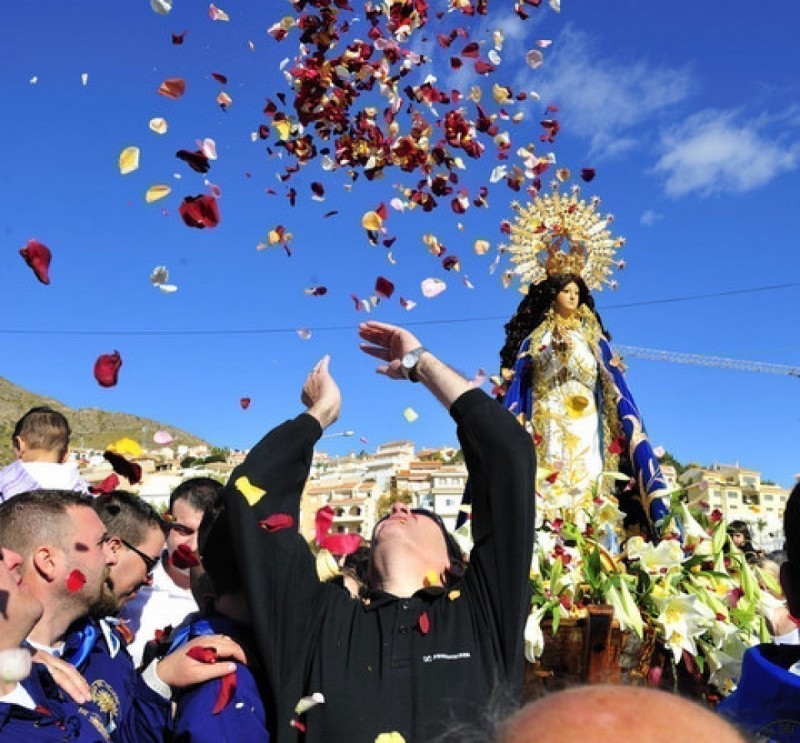 The coastal locality of Bolnuevo is part of the wide variety of landscapes and environments which can be found in the municipality of Mazarrón, its host of small coves and longer, sandy beaches making it a popular summer holiday destination as well as home to an established population of permanent residents throughout the year.
The coastal locality of Bolnuevo is part of the wide variety of landscapes and environments which can be found in the municipality of Mazarrón, its host of small coves and longer, sandy beaches making it a popular summer holiday destination as well as home to an established population of permanent residents throughout the year.
Set aside from Mazarrón and Puerto de Mazarrón, it has its own small village feel, with a full range of facilites just a few metres from the open expanses of wide, sandy beaches.
History of Bolnuevo
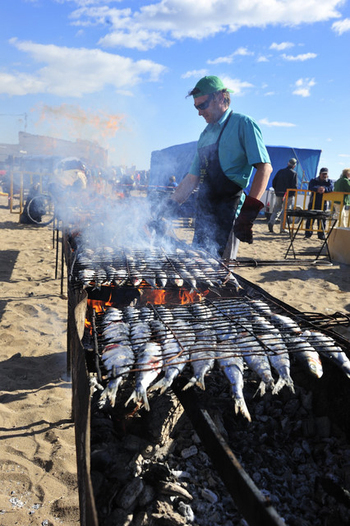 There are few traces of ancient history in Bolnuevo itself, although it was undoubtedly part of the historical events which unfolded in Mazarrón in past millennia (see history of Mazarrón).
There are few traces of ancient history in Bolnuevo itself, although it was undoubtedly part of the historical events which unfolded in Mazarrón in past millennia (see history of Mazarrón).
Close by in the Puerto de Mazarrón there are signs of activity in sites such as the Cabezo del Castellar, a location used by the Phoenicians, Greeks and Romans, who all traded along this coastline, for loading and unloading ships transporting minerals and trade goods. However, there are no physical traces of the involvement of Bolnuevo in any of the activities at that time.
The first real mention of Bolnuevo in any historical context is the documentation of the construction of a series of watchtowers along the Mazarrón coastline, and the Torre de los Caballos in Bolnuevo can still be visited today.
The proximity of this region to the African coast made it a natural target for the pirates who traded in north African ports and who frequently raided the Murcian coastline, taking hostages who were either ransomed or sold as slaves in the markets, as well as livestock and anything saleable.
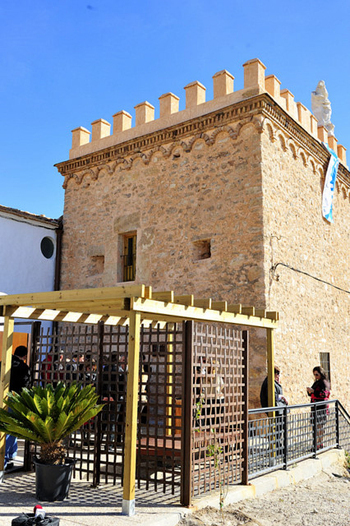 By the mid-16th century Mazarrón was occupied by around 2,100 people, who worked in the mines or earnt a living through fishing or agriculture, but due to the constant threat of attack a series of watchtowers were built to give townspeople the opportunity to seek shelter when pirate ships approached.
By the mid-16th century Mazarrón was occupied by around 2,100 people, who worked in the mines or earnt a living through fishing or agriculture, but due to the constant threat of attack a series of watchtowers were built to give townspeople the opportunity to seek shelter when pirate ships approached.
There were five towers In Mazarrón, from La Azohía in the east to Bolnuevo in the west, and the Torre del Molinete was set slightly back from the coastline to facilitate internal communication. Each was built as a defensive structure and was entered via a rope on the second floor, but their primary function was to give warning of attack, using smoke signals by day and fire by night.
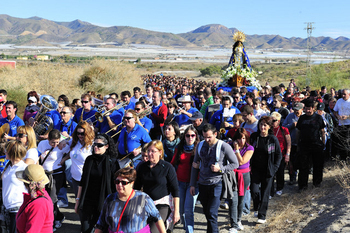 This tower is known to have been completed by 1577 as municipal records clearly show expenditure for an impending state visit, and by 1660 was being used by Bolnuevo fishermen as a net store, but had certainly fallen into disrepair by the middle of the 18th century.
This tower is known to have been completed by 1577 as municipal records clearly show expenditure for an impending state visit, and by 1660 was being used by Bolnuevo fishermen as a net store, but had certainly fallen into disrepair by the middle of the 18th century.
However, the most famous chapter in the history of Bolnuevo, the Milagro de la Purísima, took place in 1585 and was followed by the construction of a small chapel, and the building which is still linked to the Torre de los Caballos was enlarged at a later date.
The Romería of Bolnuevo is one of the best known in the Region of Murcia. It is in celebrated in honour of the Virgen de la Purísima, the patron saint of Mazarrón, and her image is kept for a few days in Puerto de Mazarrón before it is returned Bolnuevo in a spectacular parade celebrating the miracle which saved the town from attack by Berber pirates.
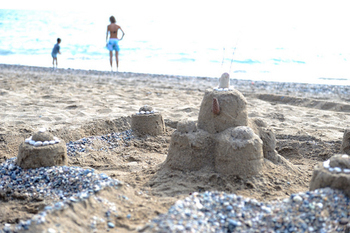 Both the tower and the church were repaired in 1946 as they had been abandoned and were in a state of near ruin, and the Torre de los Caballos was fully restored and opened to the public in 2010.
Both the tower and the church were repaired in 1946 as they had been abandoned and were in a state of near ruin, and the Torre de los Caballos was fully restored and opened to the public in 2010.
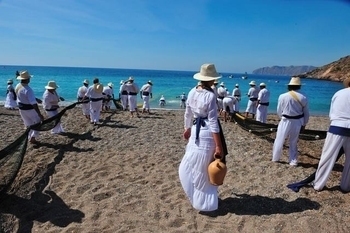 The population of Bolnuevo remained insignificant for the 200 years following the miracle due to the ever-present danger of pirate attack, and even at the peak of the mining industry in Mazarrón, around the end of the 19th century and the beginning of the 20th, Bolnuevo was still a very small fishing village similar to Cope, Calabardina and Alamillo, using the old "almadraba" fishing technique. The almadraba was used in antiquity by the Phoenicians and maintained by the Moors, and consists of a large net being dropped into the tidal current from various boats, from where it is drawn in and brought to the surface, or sometimes to the shore. Often it succeeds in trapping fish as large as tuna.
The population of Bolnuevo remained insignificant for the 200 years following the miracle due to the ever-present danger of pirate attack, and even at the peak of the mining industry in Mazarrón, around the end of the 19th century and the beginning of the 20th, Bolnuevo was still a very small fishing village similar to Cope, Calabardina and Alamillo, using the old "almadraba" fishing technique. The almadraba was used in antiquity by the Phoenicians and maintained by the Moors, and consists of a large net being dropped into the tidal current from various boats, from where it is drawn in and brought to the surface, or sometimes to the shore. Often it succeeds in trapping fish as large as tuna.
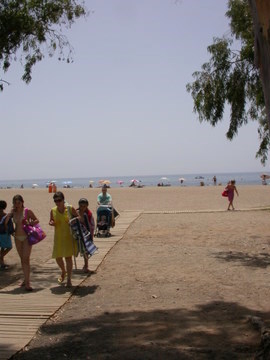 At the same time Bolnuevo, like many other small fishing villages, also maintained its old tradition in salting fish and producing delicacies such as roe, which could be prepared in situ where the catch was landed. But the fishing activity of the village declined in the middle of the 20th century and it was into this vacuum that the tourism boom stepped.
At the same time Bolnuevo, like many other small fishing villages, also maintained its old tradition in salting fish and producing delicacies such as roe, which could be prepared in situ where the catch was landed. But the fishing activity of the village declined in the middle of the 20th century and it was into this vacuum that the tourism boom stepped.
During the 1950s a building boom started, covering the hillsides of the village with modern construction while the campsite opened on the beachfront. Most of the buildings are single or double storey, so the effect is very much that of a residential community rather than a high density holiday village.
Bolnuevo is very popular with summer visitors from throughout Spain, as well as being a popular choice with residential expats or owners of second holiday homes.
The fiestas of Bolnuevo
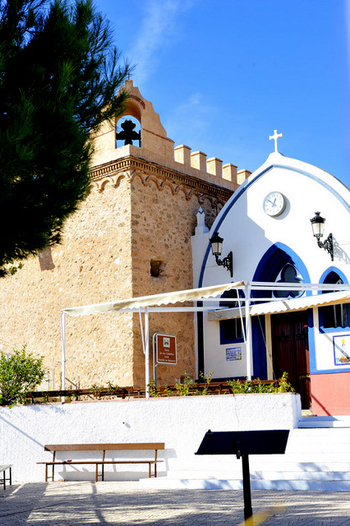 The main Fiestas Patronales are celebrated in November along with the Romeria and feature the Bolnuevo Sardine Festival. This is celebrated on the Sunday following 17th November, when the figure of the Virgin returns to Bolnuevo, although the celebrations begin beforehand with the first part of the Romeria taking place in which she is carried into Mazarrón prior to her triumphant return.
The main Fiestas Patronales are celebrated in November along with the Romeria and feature the Bolnuevo Sardine Festival. This is celebrated on the Sunday following 17th November, when the figure of the Virgin returns to Bolnuevo, although the celebrations begin beforehand with the first part of the Romeria taking place in which she is carried into Mazarrón prior to her triumphant return.
Beaches in Bolnuevo
Bolnuevo is blessed witha variety of beaches, including the wild coastline which leads to Águilas, dotted with wild rocky coves and nudist beaches and the beauty of the Sierra de las Moreras as a backdrop.
The main beach of Bolnuevo is a vast stretch of sand which stretches right along the coastline towards Mazarrón. It is extremely wide, so even in high summer there is plenty of space.
Further west lie a series of colourful rocky coves, naturist beaches and then stretches of wild, empty coastline, heading towards Percheles and Cañadas del Gallego.
The Bolnuevo erosions or Gredas de Bolnuevo
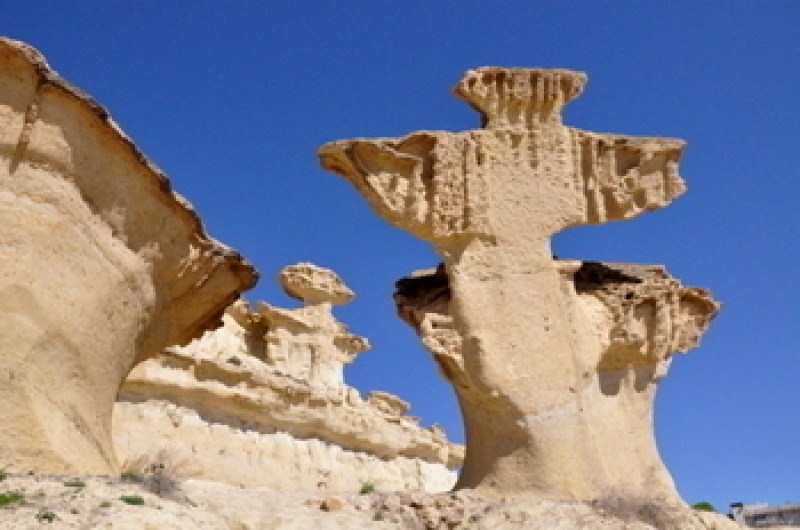 Another feature which draws visitors to the village is the "enchanted landscape" of the rock formations behind the main beach. These curious limestone shapes have been formed over millions of years by wind erosion, and seem almost like modernist sculptures. The white clay of which they consist is a mixture of silica and aluminium, and is widely used in pottery.
Another feature which draws visitors to the village is the "enchanted landscape" of the rock formations behind the main beach. These curious limestone shapes have been formed over millions of years by wind erosion, and seem almost like modernist sculptures. The white clay of which they consist is a mixture of silica and aluminium, and is widely used in pottery.
The wind erosion has been made more powerful by the fact that the air carries particles of sand and seawater, and this is what has sculpted the rocks into such a magical landscape, reminiscent to many people of giant mushrooms which seem to defy the laws of gravity. Often the rocks are the backdrop for shows and concerts during the local fiestas, and many people even choose to have their official wedding photographs taken there.
Sierra de las Moreras, Bolnuevo
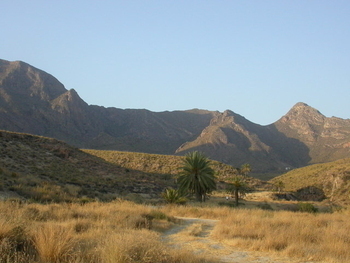 This is an important protected natural area, not only home to a wide variety of flora and fauna, but also a glorious area for walking and cycling. From the Sierra, the Rambla de las Moreras flows into the sea, reaching the Mediterranen at the Playa del Castellar, where there is an area of reeds and a natural water channel.
This is an important protected natural area, not only home to a wide variety of flora and fauna, but also a glorious area for walking and cycling. From the Sierra, the Rambla de las Moreras flows into the sea, reaching the Mediterranen at the Playa del Castellar, where there is an area of reeds and a natural water channel.
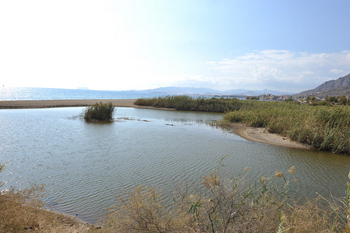 Although this is a tranquil area, it was also the scene of the worst disaster in Bolnuevo's history when it burst its banks and swept away the campsite, which at that time was closer to the sea (see Bolnuevo Gota Fría).
Although this is a tranquil area, it was also the scene of the worst disaster in Bolnuevo's history when it burst its banks and swept away the campsite, which at that time was closer to the sea (see Bolnuevo Gota Fría).
Most of the time, however, it is a tranquil location for wildlife, attracting a wide range of species.
Living in Bolnuevo as an expat
There are many expats living and owning holiday property in this area, with both apartment and residential properties available. Many families choose Bolnuevo because the hillsides are very much a residential district rather than just a holiday complex, and a selection of detatched, walled properties are available, many of them more mature than in other areas.
There are plenty of facilities available in the municipality of Mazarrón, including various health centres, a busy variety of clubs, societies, charities and sporting associations, many of them on the nearby Camposol development.
Bolnuevo is small but has a variety of shops, with a large number of bars and restaurants catering for the summer holiday trade, weekly markets, supermarkets and shops in nearby Mazarrón.
Location
For more local information including news, events and what to see and do visit the home page of Mazarrón Today.
Sights to see in Mazarrón





